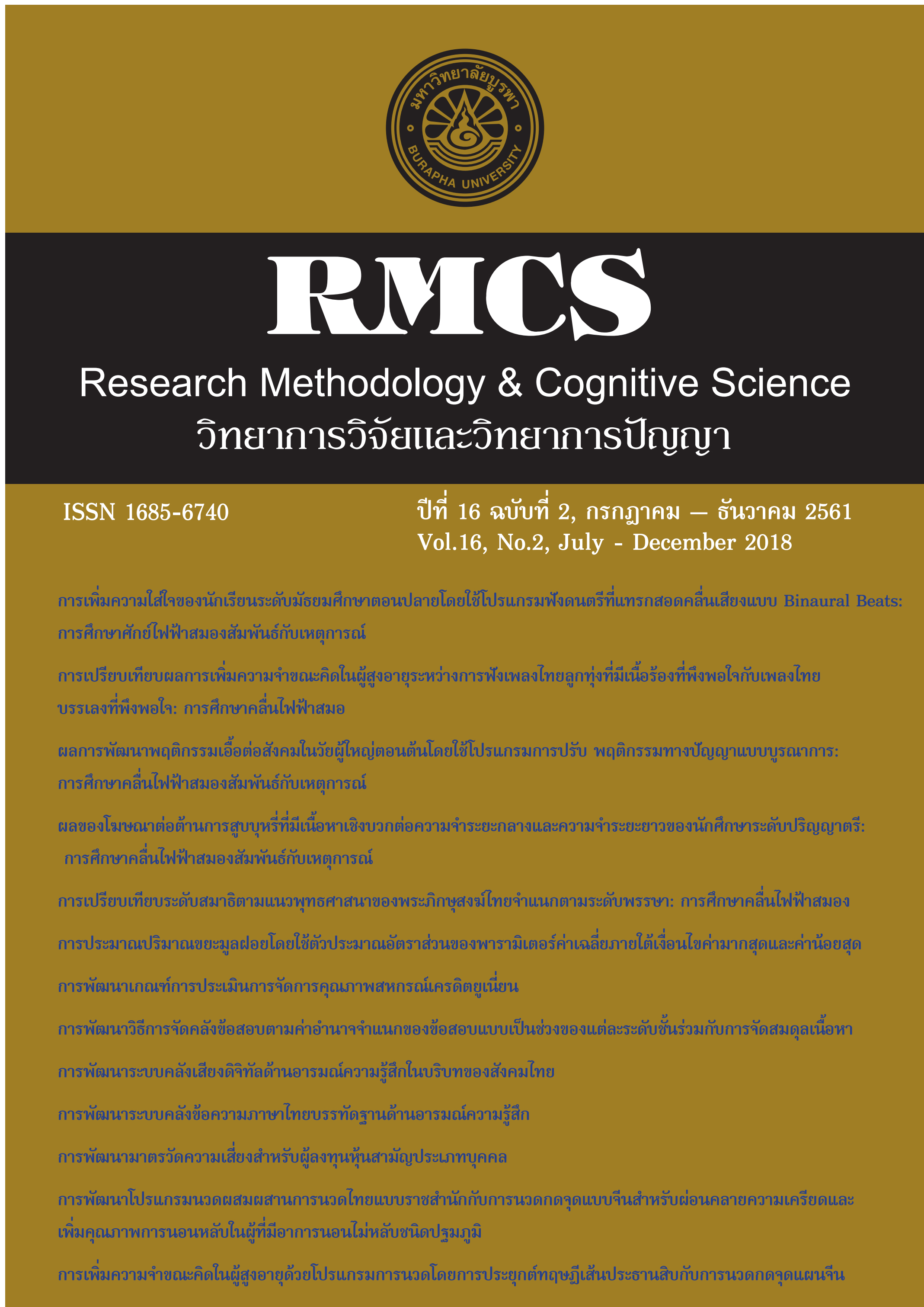A comparison of level of Buddhist meditation of Thai monks classified by year of Ordination: An electroencephalogram study
Main Article Content
Abstract
The purpose of this research was to analyze the brainwave categories of Thai Buddhist monks during meditation period classified by ordination years comparing times taken leading through the meditation stage in different years of monkhood and meditation sustainable period from different ranks of monkhood The volunteer sampling participating the experiment were 60 Thai Buddhist monks age between 20-70 years old consist of 20 Navaka monks; a newly ordained monks, 20 Majjhima monks; 5-10 years in monkhood and Thera monks; 10 years in monkhood. The measurement consisted of general questionnaire and Neuroscan system for brainwave frequencies record. The brainwave signals were recorded by MATLAB program and analyzes by descriptive statistics.
The results showed that during the meditation period, Navaka monk had brainwave most in alpha stage. Majjhima Monk had brainwave most in theta stage and Thera monks had brainwave most in delta stage. Navaka monks took 5 minutes to get into meditation and momentary sustained during 30 minutes-experiment. Whilst Majjhima monks and Thera monks wert through meditation at first minute and sustained all through 30 minutes-experiment.
It was concentration that Thai Buddhist monks’ meditation level, based on the empirical data was reasonable with Lord Buddha’s teaching in 3 level of meditation practice. Navaka monk group had brainwave most in alpha stage which was equal to Momentary Concentration (Khanikasamadhi). Majjhima monks group had brainwave most in theta stage which was equal to Access Concentration (Appanasamadhi). Last, Thera monks group had brainwave mostly at delta stage which was equal to Attainment Concentration (Upacarasamadhi)
Article Details
References
คณาจารย์มหาวิทยาลัยมหาจุฬาลงกรณราชวิทยาลัย. (2559). ธรรมภาคปฏิบัติ 1-6. (พิมพ์ครั้งที่ 2-3). กรุงเทพฯ: โรงพิมพ์มหาจุฬาลงกรณราชวิทยาลัย.
ดุสิต โพธิ์พันธุ์ และเสรี ชัดแช้ม. (2559). การเพิ่มความใส่ใจของนักเรียนจ่านาวิกโยธินโดยโปรแกรมคอมพิวเตอร์ฝึกการเคลื่อนไหว ของตาแบบติดตามวัตถุ: การศึกษาศักย์ไฟฟ้าสมองสัมพันธ์กับเหตุการณ์. วิทยาการวิจัยและวิทยาการปัญญา, 14(2), 1-18.
มหาจุฬาลงกรณราชวิทยาลัย. (2539). พระไตรปิฎกภาษาไทย 45 เล่ม. กรุงเทพฯ: โรงพิมพ์มหาจุฬาลงกรณราชวิทยาลัย.
มหาวิทยาลัยมหาจุฬาลงกรณราชวิทยาลัย. (2551). พระไตรปิฎกแก่นธรรม 6 เล่ม. กรุงเทพฯ: โรงพิมพ์มหาจุฬาลงกรณราชวิทยาลัย.
พระธรรมกิตติวงค์. (2556). คำวัด. กรุงเทพฯ: โรงพิมพ์เลี่ยงเชียง.
พจนานุกรม ฉบับราชบัณฑิตยสถาน. (2554). เฉลิมพระเกียรติพระบาทสมเด็จพระเจ้าอยู่หัว เนื่องในโอกาสพระราชพิธีมหามงคลเฉลิมพระชนมพรรษา 7 รอบ. พิมพ์ครั้งที่ 2. กรุงเทพฯ: ศิริวัฒนาอินเตอร์พริ้นจำกัด (มหาชน).
สมเด็จพระพุทธโฆษาจารย์. (2560). พุทธธรรม ฉบับปรับขยาย (พิมพ์ครั้งที่ 48). กรุงเทพฯ: สำนักพิมพ์ผลิธัมม์ ในเครือบริษัท สำนักพิมพ์เพ็ทแอนด์โฮม จำกัด.
สำนักงานพระพุทธศาสนาแห่งชาติ. (2549). พระไตรปิฎกภาษาไทย ฉบับเฉลิมพระเกียรติพระบาทสมเด็จพระเจ้าอยู่หัว 45 เล่ม. กรุงเทพฯ: บริษัทอมรินทร์พริ้นติ้งแอนด์พับลิชชิ่ง จำกัด (มหาชน).
สมเด็จพระญาณสังวร สมเด็จพระสังฆราช. (2554). สมาธิในพระพุทธศาสนา. (พิมพ์ครั้งที่ 5). กรุงเทพฯ: มหามกุฎราชวิทยาลัย.
Anwar, D., Garg, P., Naik, V., Gupta, A., & Kumar, A. (2018). Use of Portable EEG Sensors to Detect Meditation. In Communication Systems & Networks (COMSNETS), 2018 10th International Conference on (pp. 705-710). IEEE.
Cahn, B. R., & Polich, J. (2013). Meditation states and traits: EEG, ERP, and neuroimaging studies. Psychology of Consciousness: Theory, Research, and Practice, 1, 48-96.
Edmonds, W. A., & Kennedy, T. D. (2017). An Applied Guide to Research Designs: Quantitative, Qualitative, and Mixed Methods. California: Sage Publications.
Fingelkurts, A. A., Fingelkurts, A. A., & Kallio-Tamminen, T. (2015). EEG-guided meditation: a personalized approach. Journal of Physiology-Paris, 109(4-6), 180-190.
FO, E., MED, S., & BA, N. (2012) Samatha-Vipassana Meditation Based on The Five Meditation Techniques. Nakorn Pathom: Petkaserm Printing Group Co., Ltd.
Fox, K. C., Dixon, M. L., Nijeboer, S., Girn, M., Floman, J. L., Lifshitz, M., & Christoff, K. (2016). Functional neuroanatomy of meditation: A review and meta-analysis of 78 functional neuroimaging investigations. Neuroscience & Biobehavioral Reviews, 65, 208-228.
Galante, J., Galante, I., Bekkers, M. J., & Gallacher, J. (2014). Effect of kindness-based meditation on health and well-being: a systematic review and meta-analysis. Journal of Consulting and Clinical Psychology, 82(6), 1101-1114.
Guleria, A., Kumar, U., Kishan, S. S. K., & Khetrapal, C. L. (2013). Effect of SOHAM meditation on the human brain: an fMRI study. Psychiatry Research: Neuroimaging, 214(3), 462-465.
Hagerty, M. R., Isaacs, J., Brasington, L., Shupe, L., Fetz, E. E., & Cramer, S. C. (2013). Case study of ecstatic meditation: fMRI and EEG evidence of self-stimulating a reward system. Neural plasticity, 2013.
Harne, B. P., & Hiwale, A. S. (2018). EEG Spectral Analysis on OM Mantra Meditation: A Pilot Study. Applied Psychophysiology and Biofeedback, 43(2), 1-7.
Jirayucharoensak, S., Pan-Ngum, S., & Israsena, P. (2014). EEG-Based Emotion Recognition Using Deep Learning Network with Principal Component Based Covariate Shift Adaptation. The Scientific World Journal, 2014.
Lagopoulos, J., Xu, J., Rasmussen, I., Vik, A., Malhi, G. S., Eliassen, C. F., & Davanger, S. (2009). Increased theta and alpha EEG activity during nondirective meditation. The Journal of Alternative and Complementary Medicine, 15(11), 1187-1192.
Lomas, T., Ivtzan, I., & Fu, C. H. (2015). A systematic review of the neurophysiology of mindfulness on EEG oscillations. Neuroscience & Biobehavioral Reviews, 57(1), 401-410.
Lutz, J., Herwig, U., Opialla, S., Hittmeyer, A., Jancke, L., Rufer, M., & Bruhl, A. B. (2014). Mindfulness and emotion regulation an fMRI study. Social Cognitive and Affective Neuroscience, 9(6), 776-785.
Manna, A., Raffone, A., Perrucci, M. G., Nardo, D., Ferretti, A., Tartaro, A., & Romani, G. L. (2010). Neural correlates of focusedF attention and cognitive monitoring in meditation. Brain Research Bulletin, 82(1), 46-56.
Nakata, H., Sakamoto, K., & Kakigi, R. (2014). Meditation reduces pain-related neural activity in the anterior cingulate cortex, insula, secondary somatosensory cortex, and thalamus. Frontiers in Psychology, 5.
Newberg, A. B. (2014). The neuroscientific study of spiritual practices. Frontiers in psychology, 5.
Travis, F., & Shear, J. (2011). Focused attention, open monitoring and automatic self-transcending: categories to organize meditations from Vedic, Buddhist and Chinese traditions. Consciousness and Cognition, 19(4), 1110-1118.
Thomas, S., & Rao, S. L. (2016). Neuroscience of meditation and its implications. Indian Journal of Positive Psychology, 7(1), 135-137.

